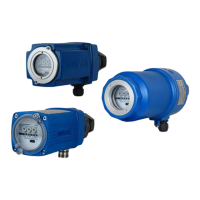3 | Explosion protection
24
D-LX 201/721
Kollaustrasse 105
D-LX 201 *-*/*/87Ex/*
II 3 G Ex nAnC IIC T6, T4 Gc
II 3 D Ex tc IIIC T85, 135°C Dc
IECEx IBE11.0014
-40°C Ta +40°C (T6), 65°C (T4) ≤ ≤
3
1
2
5
4
1
Manufacturer
2
Manufacturer address
3
Device type
4
Ex labelling (see following tables for meanings)
5
Ambient temperature
Fig.3.1: Ex type label (example)
Informa-
tion
Meaning
II
Device group II = other hazardous areas (not the mining industry)
3 G
Device category 3 G = zone 2 atmosphere (gas)
Ex nAnC
nA = non-sparking operating material, nC = the contacts of sparking oper-
ating materials are protected in a suitable manner (ignition protection
types for electrical operating materials in areas at risk of gas explosions)
IIC
IIC = explosion group for gases (as per IEC, CENELEC and NEC 505; typ-
ical gas: hydrogen)
T4
T4 = temperature class for gases (maximum permissible housing surface
temperature 135 °C; as per IEC, CENELEC and NEC 505)
T6
T6 = temperature class for gases (maximum permissible housing surface
temperature 85 °C; as per IEC, CENELEC and NEC 505)
Gc
Device protection level: Gc corresponds to zone 2
Table3.3: Ex labelling, gas (example!)
Informa-
tion
Meaning
II
Device group II = other hazardous areas (not the mining industry)
3 D
Device category 3 D = zone 22 atmosphere (dust)
Ex tc
tc = protection by means of a housing (ignition protection type for electrical
operating materials in areas at risk of dust explosions)
IIIC
IIIC = conductive dust (as per IEC, CENELEC and NEC 505)
T85°C
T85°C = highest permissible surface temperature for dust (as per IEC,
CENELEC and NEC 505)
T135°C
T135°C = highest permissible surface temperature 135 °C (as per IEC,
CENELEC and NEC 505)
Dc
Device protection level: Dc corresponds to zone 22
Table3.4: Ex labelling, dust (example!)

